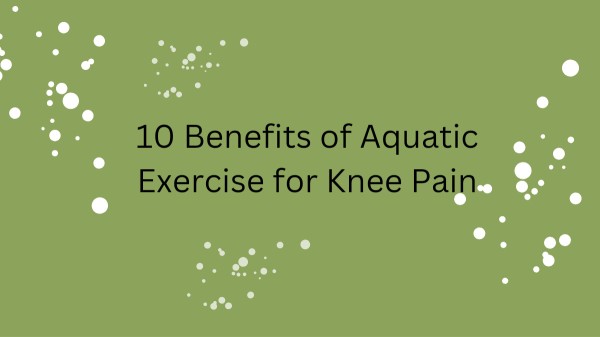benefits of aquatic exercise for knee pain is a common problem that affects many people of different ages and activity levels. It can limit your mobility, affect your quality of life, so we’ll explain how aquatic exercise can benefit your knees, what types of aquatic exercise are best for knee pain, and how to start aquatic exercise safely and effectively.
Benefits of aquatic exercise for knee pain
Aquatic exercise is a great way to safely work your knees. The added buoyancy allows you to keep the weight off the joint but still allows you to resist building muscles and tendons. This reduces the weight on your joints for movements like squats, lunges and even jumps.Knee pain can be helped by aquatic exercise:
- Reducing joint stiffness.
- Strengthening muscles around your joints.
- Increasing flexibility.
- Allowing better blood flow to the area, which will aid in the healing process.
- Reducing swelling and edema over time.
If you’re looking for specific exercises, here are some aquatic exercises that can help with knee pain:
Water Walking: Walking in waist-high water. Use a slow, steady motion with your knees raised as you move forward. You can also walk backwards or sideways.
Leg swing: Stand in waist-high water. Hold the edge of the pool with one hand. Swing one leg forward and back, then switch to the other leg. Repeat 10 to 15 times on each leg.
Knee lifts: Stand in waist-high water. Hold the edge of the pool with one hand. Lift one knee up toward your chest, then lower it. Repeat 10 to 15 times on each leg.
Please note that before starting any new exercise program, it is important to consult with your doctor or physical therapist to make sure it is safe for you to do so.
What are some other aquatic exercises
Here are some more aquatic exercises that can help with knee pain:
- Water aerobics: This is a low-impact exercise that can help improve your cardiovascular health and strengthen your muscles. You can do exercises such as jumping jacks, leg lifts, and arm curls in the water.
- Swimming: Swimming is a great way to work out your entire body, including your knees. You can do different strokes such as freestyle, breaststroke, and backstroke to work different muscle groups.
- Water cycling: This is a great way to get a cardio workout without putting too much stress on your knees. You can use a stationary bike that’s submerged in water to cycle.
- Water jogging: This is a great way to get your heart rate up without putting too much stress on your knees. You can jog in place or move around the pool.
Please note that before starting any new exercise program, it’s important to consult with your doctor or physical therapist to ensure that it’s safe for you to do so.
How long should I exercise for knee pain relief
The time it takes to see results from aquatic exercise can vary depending on the individual’s fitness level, workout intensity, and exercise frequency.
According to an article in Leisure Swimming, it can take an average of 6 to 8 weeks to see signs of progress. However, it’s important to remember that everyone’s body is different, and results may vary.
In a Reddit thread, a user reported seeing results after going to the gym for about an hour 3-5 times a week for about five months.
Another Trusted Spotter article suggests that in just one month of swimming workouts, you can lose a few pounds due to high-calorie burn and quickly improve your swim times and overall conditioning.
Please note that the duration of aquatic exercise for knee pain relief depends on the severity of your pain and your overall physical health.
According to the Centers for Disease Control and Prevention, people with knee arthritis should get at least 30 minutes of moderate exercise per day, five days a week.
However, it is important to consult with your doctor or physical therapist to determine the appropriate duration and intensity of exercise that is safe for you.
How can I make my aquatic workout more challenging
There are several ways to make your aquatic workout more challenging. Here are some ideas:
Increase resistance: You can use equipment like foam dumbbells or pedals to increase resistance and build strength.
Add intervals: You can add interval training, which alternates between low- and high-intensity exercise.
Try Different Strokes: You can try different strokes like freestyle, breaststroke and backstroke to work different muscle groups.
Speed up: You can speed up your pace to increase your heart rate and burn more calories.
Increase the duration: You can increase the duration of your workout to improve your endurance and burn more calories.
Please note that before starting any new exercise program, it is important to consult with your doctor or physical therapist to make sure it is safe for you to do so.
